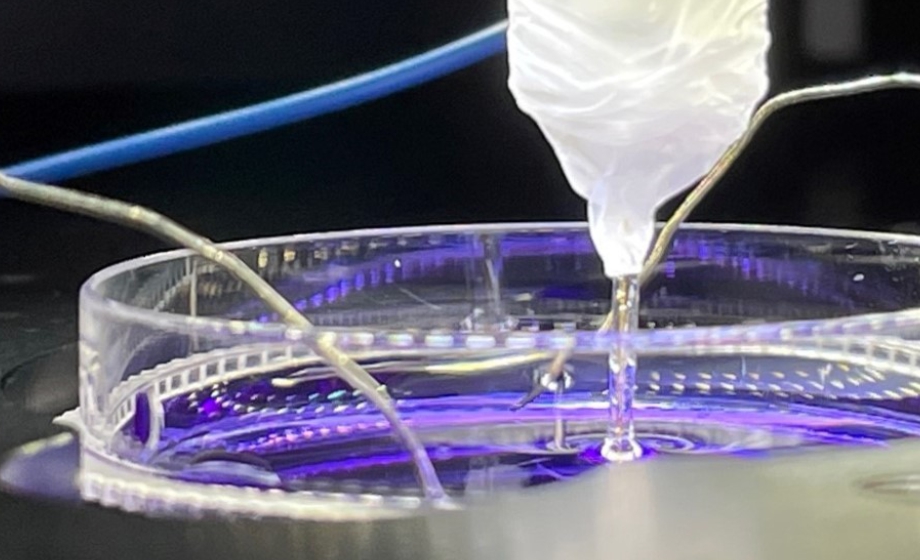Q&A Report: Molecule Transport across Cell Membranes: Electrochemical Quantification at the Microscale

Answers to these questions have been provided by:
Sabine Kuss, PhD
Associate Head of Graduate Studies
Associate Professor, Department of Chemistry
University of Manitoba
Would SECM inside a organoid be possible?
Studies have been reported (e.g. by Michael Mirkin and co-workers) where a nanoelectrode was used to penetrate the cell wall to carry out scanning SECM intracellularily. Because of the small size of the SECM tip this invasive procedure does not ultimately lead to cell death.
What sort of expertise in my lab do I need to perform SECM experiments on biological samples?
Any electrochemist can learn how to carry out SECM measurements effectively. As the SECM is a complex instrument, I recommend to access training and workshops provided by SECM providers, such as HEKA. Once one is familiar with imaging solid samples, biological cells become accessible, but it is crucial to consider environmental factors, such as temperature fluctuations, which could potentially affect the cellular response. Idealy, you have someone in your team who is familiar with cell physiology to advise on proper experimental conditions to avoid artificial current signals.
What are some considerations when using biological samples in a SECM imaging environment?
Important considerations should include stable and reliable thermostation of the electrochemical cell, light exposure, media composition, scan velocity, which might induce mechanical stress on cells, cell cylcle stage, and cell age (passage). We conducted a thorough analysis on these factors and manuscripts are currently under review (2023). Please look out for these studies when they become published.
What is the diameter of your SECM electrodes?
The electrodes mentioned in this talk are 25 µm in diameter. However in the literature you will be able to find procedures for the fabrication of ultramicro- and nanoelectrodes (e.g. by Janine Mauzeroll and co-workiers).
In your study of Chemoresistance imaging, it seems that the target cell showed two hot spots with higher tip currents. Could you please explain a bit more about this, in terms of why two hot spots (not one hot spot) were observed?
In the example of chemoresistance imaging, we were imaging two cells that are located side by side. After seeding cells in the Petri dish, they were incubated in cell growth medium for at least 8 hours before SECM imaging. During this time, cells naturally divide and are found in groups of 2 thereafter. Therefore, we aim to image groups of two cells, not single cells, as a healthy metabolism (or adjusted metabolism after seeding) cannot be assured in single cells.
How can we work SECM over biomaterials coated on flexible substrates?
Flexible surfaces can be challanging to image, as an uneven substrate might require a greater tip-to-substrate distance to avoid the collision of the electrode with the surface. This might decrease the resolution of SECM imaging in constant-height. There are methods to achieve constant-distance imaging, where an electrode keeps a constant distance across the surface by adjusting the height of the electrode automatically with changing topography. However, not everyone has access to constrant distance imaging (e.g. by shear force). Although possible, constant-distance imaging of soft/flexible substartes is not trivial, as amplitude or phase shifts are harder to monitor. Should the electrode collide with a soft substrate the shear force signal might not be able to recover due to tip-contamination.
Would the shape of the probe alter the resolution of the peaks?
Yes. It is important to work with electrodes that exhibit a very well defined geometry, otherwise results will not be repeatable and reproducible in their entirety.
What research avenue or development in the field are you most excited about pursuing moving forward?
There are countless opportunities related to the SECM technology. Today I presented how we can use SECM to identify redox-active metabolic and disease indicators. I can envision applications to study cell-cell communication, and quorum sensing. Personally I am intrigued by the combination of SECM with other methods, such as atomic force microscopy to increase resolution and to measure specific cell features.
Does local motility of cells pose an issue during measurements?
Motility of cells is usually not an issue, as our SECM measurements only take a few seconds. If 3D-imaging is performed, which can take 1-2 hours, cell motility can be restricted by creating oxygen plasma treated areas on the plastic surface. Cells will be attracted to stay in these 50 µm sized islands. We conciously avoid using chemical compounds to immobilize cells, as this can cause significant changes in cell metabolism.
Please see our 2013 publication in PNAS for more information. Kuss S., Polcari D., Geissler M., Brassard D., Mauzeroll J.: Assessment of multidrug resistance on cell coculture patterns using scanning electrochemical microscopy. Proceedings of the National Academy of Sciences of the United States of America 2013, 110 (23), 9249.
I’m a beginner of SECM, and I’m interested in using SECM for bacterial signal detection. Unlike mammalian cells, bacterial cells are smaller and hard to detect or map without entrapment or immobilization. Besides making the probe size smaller, are there any other methods to improve the resolution for bacterial mapping or signal detection?
To image bacteria by SECM, I first recommend to work with a microscopy magnification that is sufficient to visually observe your samples (at least 40x, ideally 100x). Cell motility presents a bigger issue in bacteria imaging compared to mammalian cells. You may have to explore strategies to gently adhere bacteria to the surface, so that cells don’t “run away”. Poly-L-lysin might be a good option, but will render the surface of your substrate too rough if the layer is too thick. If the surface is too uneven, it might be difficult to see bacterial signals, due to their small size and low currents that will be recorded. To increase the resolution, a small (ideally nanometer size) electrode is needed and the tip-to-substrate distance should be kept as small as possible. This can be challenging if the substrate exhibits a slope.